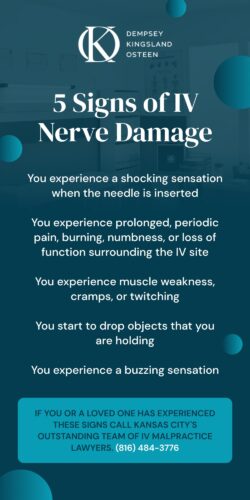
Whenever we’re hospitalized, we put our faith in the doctors, nurses, and staff to take good care of us while we’re vulnerable and in pain. However, even skilled professionals can make mistakes, such as common IV insertion errors, which can lead to complications and discomfort.
One of the common features of being hospitalized is receiving fluids or medicines through an IV. It’s so common we barely think about whether it could be dangerous, but there is such a thing as a bad IV stick.
What happens if an IV is not inserted in the vein? If you have been injured from a bad IV stick, you may have a nursing malpractice case. Contact our experienced Kansas City medical malpractice lawyers today. We have won millions for our clients and want to hear about your case.
Know About the Complications You Can Suffer from with IV Insertion
What Happens If the IV Is Not in a Vein?
Missing a vein during insertion causes infiltration, a blown vein, or nerve injury. Seek medical advice if the area becomes hot, painful, swollen, red, or dark, depending on skin color.
The intended medicine or fluids won’t reach the bloodstream, leading to ineffective treatment. This is called IV infiltration, and it can cause harm ranging from irritation to fluid overload, infections, nerve damage, stroke, brain injury, or even death.
When an intravenous (IV) injection is not properly administered into a vein, the injected fluids may escape into the surrounding tissues instead of remaining within the bloodstream.
This can lead to localized swelling and tissue damage at the site of the IV insertion. It’s essential to ensure that IVs are correctly placed in veins to prevent these complications and ensure the safe delivery of fluids or medications.
Certain medications require special care when administered by IV because they are irritating or even corrosive. Infiltration of these medications into tissue surrounding an IV can cause second or third-degree burns, permanent scarring, and injuries serious enough to require amputation.
See what our clients have to say about our services:
Can a Bad IV Cause Nerve Damage?
In the event that an intravenous (IV) catheter penetrates a nerve, it can cause temporary or permanent nerve damage.
Following an injury, the nerve will attempt to regenerate; however, recovery is not always possible. IV nerve damage can take anywhere from a few weeks to years to subside, if at all.
How do you know if you have IV nerve damage? See below:
- You experience a shocking sensation when the needle is inserted
- You experience prolonged, periodic pain, burning, numbness, or loss of function surrounding the IV site
- You experience muscle weakness, cramps, or twitching
- You start to drop objects that you are holding
- You experience a buzzing sensation
You can determine if an IV is in the wrong place by observing signs such as intense swelling and noticeable bruising.
Patients are more likely to bruise if multiple IV attempts were needed or if IV failure, such as infiltration, occurred. While a bruised IV site may appear alarming, bruising around the area is common. An IV bruise forms when blood leaks under the skin after an IV catheter is inserted or removed.
These symptoms are indicative of IV infiltration, a condition where fluids or medications are mistakenly delivered into the surrounding tissue instead of the intended vein.
What Will Happen if the Dextrose is Not Dropping?
If a dextrose IV is not dropping, the fluid is not being administered properly. This can lead to complications such as fluid overload, causing headache, high blood pressure, and difficulty breathing. Severe cases may result in tissue damage at the IV site due to fluid buildup from improper needle placement.
What Happens if IV Drip is Too Fast?
Fluid overload can cause headaches, high blood pressure, and breathing difficulties when too much fluid is given too quickly. Adjusting fluid levels typically resolves these symptoms, but the condition can be dangerous. A hematoma occurs when blood leaks from a blood vessel into surrounding tissues.
IV Angle of Insertion
Vary the needle entry angle based on the device and vein depth.
Use a 22-24 gauge catheter at a 10-25º angle for small veins.
Use a larger catheter at a 30-45º angle for deeper veins.
IV Infiltration and Common Errors
If an IV misses a vein, you might feel pain, swelling, or notice bruising at the site. This can increase the risk of infection or tissue damage. Seek medical advice if the area becomes hot, red, increasingly painful, swollen, or discolored.
According to the CDC’s 2011 guidelines for the prevention of intravascular catheter-related infections, some common errors by hospitals and medical staff that can cause IV infiltration or related complications include:
- Failure to evaluate the insertion site daily for signs of irritation or infiltration.
- Failure to immediately remove the IV when infiltration is detected.
- Using steel IV needles when administering certain medications and fluids that can cause tissue death if they should infiltrate tissue.
- Choosing the wrong IV location.
- Neglecting to promptly replace IV catheters that were inserted during emergencies when sterile conditions could not be ensured, or to remove those no longer essential.
By avoiding these common IV insertion errors and following best practices, healthcare professionals can ensure safer and more effective IV access for patients.
Recent IV Infiltration Settlement for $200,000
The Case: Our client, a newborn, sustained a walnut sized scarring injury from infiltration of an IV. The newborn was receiving care in an intensive care unit when the infiltration occurred due to a lack of monitoring. A nurse attempted to hide her failure to monitor the IV by altering the child’s medical chart. We presented both a demand letter and PowerPoint presentation to the defendant hospital that discussed the standards that apply to proper IV monitoring, the nursing failures, photographs depicting the child’s injury and a report from a plastic surgeon describing the necessary surgery and cost to revise the child’s scarring. The case settled before trial for $200,000.
Disclaimer: Please keep in mind that testimonials or reviews do not constitute a guarantee, warranty, or prediction regarding the outcome of your legal matter, as the facts and circumstances of each case differ.
Common IV Insertion Errors: Avoid These Mistakes
- Catheter Length:
- Mistake: Using a catheter that is too short.
- Solution: Ensure the catheter length is appropriate for the patient’s vein and the intended purpose. Using a catheter that is too short can lead to complications and discomfort during IV therapy.
- Needle and Catheter Depth:
- Mistake: Failing to insert the needle and catheter deep enough into the vein.
- Solution: Properly assess the depth of the vein and insert the needle and catheter to the correct depth. Shallow insertion may result in infiltration or dislodgment of the IV line.
- Needle Insertion Angle:
- Mistake: Inserting the needle at too steep an angle.
- Solution: Maintain the correct angle of insertion, typically around 15-30 degrees, to avoid complications like puncturing through the vein or causing unnecessary discomfort to the patient.
Injured By IV Not in Vein? Contact Dempsey Kingsland Osteen Now
It all beings with a call. When speaking with our malpractice attorneys we can help you determine if you have an IV malpractice case or not. If you were injured by a bad iv stick you should call experienced Kansas City IV malpractice lawyers today.
It’s shocking that misconceptions and errors persist when IV therapy is so common. Ideally, IV infiltration shouldn’t happen, and it certainly shouldn’t be allowed to persist for more than 24 hours.
It’s an enormous tragedy that anyone should be seriously harmed or a life lost due to such an easily avoidable hospital error, but it does happen, and we know how to prove medical negligence.
If you or a loved one has been harmed by an IV error, you have the right to answers — and justice. Turn to the medical malpractice attorneys at Dempsey Kingsland & Osteen for the guidance you deserve. Contact us today.
We handle cases in Kansas City, Blue Springs, Raymore, Raytown, Independence, Liberty, Olathe, Mission, Lenexa, as well as the state of Kansas.
Bad IV Insertion FAQs
What Should I Do If I Think My IV Was Done Wrong?
Speak up right away. Let the nurse or doctor know if something feels wrong with your IV. Take photos of any visible symptoms like swelling or bruising, and write down what you’re experiencing. If the problem isn’t addressed or you’re unsure what to do next, consulting with a medical malpractice attorney can help protect your rights.
Can I File a Claim If I’ve Been Hurt by an IV Insertion Error?
Yes, you can. If a healthcare provider’s negligence caused harm, like failing to monitor your IV or placing it incorrectly, you might have a malpractice case. An experienced IV malpractice lawyer can help you understand your rights and pursue justice if you’ve been injured.
Can IV Infiltration Cause Long-Term Damage?
Yes, IV infiltration can cause long-term damage. Mild cases often resolve without issue, but severe infiltration can lead to permanent nerve damage, tissue necrosis, or functional loss. Prompt detection and treatment reduce the risk of complications and improve recovery outcomes.
How Can You Tell If an IV Is Not Inserted Correctly?
If an IV isn’t properly inserted, you might notice signs like swelling, redness, or bruising around the site. It could also feel painful, burn, or look pale and cool to the touch. If the fluid isn’t flowing as it should or the area looks off, alert the medical staff immediately. Catching this early can prevent serious complications.
How Long Should Arm Hurt After IV?
Arm pain after an IV typically lasts a few hours to 2–3 days. Mild soreness, bruising, or swelling is normal and usually fades quickly. If pain persists beyond three days or includes redness, warmth, or fever, it may indicate phlebitis or vein injury and requires medical evaluation.
If you or someone you love was injured due to an IV improperly inserted, call Dempsey Kingsland Osteen at (816) 484-3776 or contact us via online form. Your initial consultation with our medical malpractice lawyers is free of charge.



